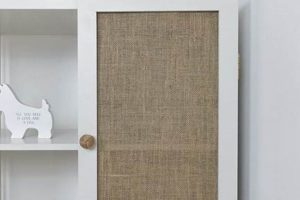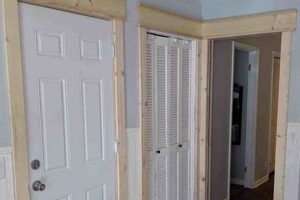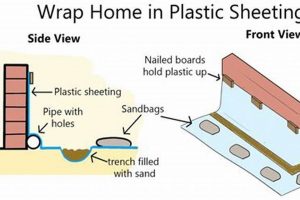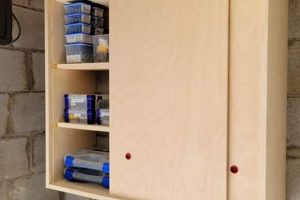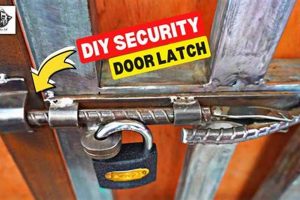A concealed entrance, cleverly disguised as a shelving unit, provides a unique architectural feature within a dwelling. This structural modification involves adapting a standard or custom-built bookcase to function as a pivotable entryway. The resulting installation creates a hidden passage, blending seamlessly with surrounding walls and shelving.
The inclusion of such a feature offers various advantages, ranging from increased security to novel space utilization. Historically, hidden passages and rooms have served to safeguard valuables, provide refuge, or maintain secrecy. Modern applications often prioritize aesthetic appeal, creating playful surprises within a home’s design while potentially augmenting property value through the addition of distinctive elements.
The subsequent sections will delve into the practical aspects of designing and constructing this type of concealed entryway, encompassing considerations related to structural integrity, hinge mechanisms, locking systems, and aesthetic integration with existing dcor.
Essential Construction Guidance
Successful integration of a concealed bookshelf entryway demands meticulous planning and execution. The following guidance outlines critical aspects to ensure structural integrity, functional operation, and aesthetic coherence.
Tip 1: Structural Assessment: Prior to any modifications, assess the wall’s load-bearing capacity and framing. Reinforcements may be necessary to support the weight of the filled bookshelf and the forces exerted during operation.
Tip 2: Precision Measurements: Accurate measurements of the opening and bookshelf dimensions are paramount. Ensure sufficient clearance for smooth pivoting, accounting for flooring variations and potential obstructions.
Tip 3: Robust Hinge Selection: Employ heavy-duty pivot hinges specifically designed for substantial weight loads. Consider concealed hinges to maintain the disguise and prevent premature failure.
Tip 4: Secure Locking Mechanism: Integrate a robust locking system to ensure both security and seamless concealment. Magnetic latches, hidden bolts, or keyed locks can be incorporated to maintain the illusion.
Tip 5: Counterbalance System: For larger or heavier units, implement a counterweight or spring-assisted mechanism. This minimizes stress on the hinges and facilitates effortless opening and closing.
Tip 6: Aesthetic Integration: Match the bookshelf’s finish, style, and detailing to the surrounding dcor. Employ consistent paint colors, trim profiles, and hardware to achieve a seamless visual transition.
Tip 7: Safety Considerations: Ensure the entryway conforms to all relevant building codes and safety regulations. Implement safeguards to prevent accidental entrapment or injury.
By adhering to these guidelines, a concealed bookshelf entryway can be seamlessly integrated into a dwelling, offering a blend of security, functionality, and aesthetic intrigue.
The subsequent section will explore potential design variations and advanced features for this concealed architectural element.
1. Precise Measurements
The functional efficacy of a bookshelf concealing an entryway hinges critically on the accuracy of measurements taken during the planning and construction phases. Imprecise dimensions propagate errors throughout the entire project, leading to misalignment, operational difficulties, and ultimately, a compromised illusion. For instance, if the width of the door frame deviates by even a fraction of an inch from the bookshelf’s internal dimensions, the door may bind, preventing smooth swinging, or exhibit unsightly gaps that reveal its true nature. Proper function requires attention to detail.
The interdependence of accurate measurements and successful project completion is evident in several practical scenarios. Consider the selection and placement of hinge mechanisms. If the distance between hinges is miscalculated, the door’s weight distribution becomes uneven, potentially causing premature wear or failure. Similarly, precise measurement of the wall opening ensures a snug fit for the bookshelf unit, preventing unwanted movement and enhancing structural stability. This understanding applies across many fields.
In summary, precise measurements serve as the foundation upon which a functional and aesthetically pleasing concealed bookshelf entrance is built. Errors in this critical area cascade throughout the entire project, undermining its intended purpose. While challenges may arise in obtaining and maintaining accuracy, the investment in careful measurement is indispensable for realizing a successful concealed entryway.
2. Robust Hinge Mechanism
The functional integrity of a bookshelf concealing an entryway is inextricably linked to the employed hinge mechanism. The hinges bear the full weight of the bookshelf, its contents, and any additional stress imposed during operation. Consequently, the selection of a suitably robust hinge mechanism is paramount for ensuring longevity, smooth operation, and structural safety.
- Load-Bearing Capacity
The hinge mechanism must possess a sufficient load-bearing capacity to support the combined weight of the bookshelf, its contents, and any dynamic forces encountered during opening and closing. Exceeding the hinge’s rated capacity can lead to premature failure, resulting in door sagging, operational difficulties, and potential structural collapse. For example, a standard residential door hinge would be inadequate for supporting a fully loaded bookcase constructed of solid hardwood.
- Hinge Type and Material
Various hinge types exist, each with varying degrees of robustness and suitability for this application. Pivot hinges, designed to support heavy loads and provide smooth rotation, are often preferred. The hinge material should be selected based on its strength, durability, and resistance to corrosion. Steel and stainless steel alloys are commonly employed due to their superior mechanical properties. Concealed hinges contribute to the element of surprise.
- Durability and Longevity
The hinge mechanism should exhibit exceptional durability to withstand repeated use over an extended period. Factors influencing durability include material quality, manufacturing tolerances, and environmental conditions. Hinges subjected to excessive stress or corrosive environments are prone to premature wear and failure. Regular maintenance, such as lubrication, can extend the lifespan of the hinge mechanism.
- Ease of Installation and Adjustment
While robustness is crucial, the hinge mechanism should also be relatively easy to install and adjust. Complex installation procedures can increase the risk of errors, compromising the integrity of the door. Adjustable hinges allow for fine-tuning of the door’s alignment, ensuring smooth and consistent operation. Proper installation requires precision.
In summary, a robust hinge mechanism is a critical component of any bookshelf concealing an entryway. Careful consideration of load-bearing capacity, hinge type, material, durability, and ease of installation is essential for ensuring the long-term functionality, safety, and aesthetic appeal of the concealed entrance.
3. Concealed Locking System
The integration of a concealed locking system is a critical determinant of a concealed bookshelf entryway’s effectiveness, directly influencing its security and illusion. The primary purpose of such a system is to secure the entryway while maintaining the visual continuity of the bookshelf. The absence of visible locking mechanisms prevents detection, reinforcing the perception that the bookshelf is merely a decorative or functional storage unit rather than a concealed portal. The sophistication and effectiveness of the locking system directly correlate with the level of security and secrecy the entryway provides.
Various locking mechanisms can be adapted for this purpose, each offering a distinct balance between security and concealment. Magnetic latches offer a basic level of security while remaining entirely invisible, relying on magnetic force to hold the door in place. Hidden bolts, operated via a concealed lever or mechanism, provide enhanced security and are more resistant to forced entry. Keyed locks, while offering the highest level of security, require careful integration to avoid detection, often necessitating the use of false book spines or other inconspicuous disguises to conceal the keyhole or locking cylinder. For example, a mechanism could be connected to a specific book, which must be pulled or rotated in a specific manner to disengage the lock. It enhances the effect.
The selection and implementation of a concealed locking system require careful consideration of the specific security needs and design constraints of the entryway. Balancing the desire for maximum security with the need for seamless concealment presents a significant design challenge. Regardless of the chosen mechanism, precise installation and thorough testing are essential to ensure reliable operation and prevent unintended disclosure. Ultimately, a well-designed and properly installed concealed locking system transforms a standard bookshelf into a functional, secure, and undetectable entryway.
4. Structural Reinforcement
Structural reinforcement is an indispensable element in the construction of a bookcase concealing an entryway. This aspect addresses the inherent instability introduced by transforming a stationary shelving unit into a movable partition. Without adequate reinforcement, the modified structure is susceptible to collapse, operational failure, and potential safety hazards.
- Frame Augmentation
The original frame of the bookcase is typically not designed to withstand the stresses associated with repeated swinging and the concentrated loads at the hinge points. Reinforcement often involves the addition of internal bracing, such as steel tubing or solid wood members, to distribute weight and resist deformation. For instance, welding steel supports to the corners of a bookcase constructed from particleboard significantly increases its rigidity and load-bearing capacity. Adequate attention to frame integrity is critical.
- Hinge Mounting Enhancement
The points where hinges are attached to the bookcase and the adjacent wall are particularly vulnerable to stress. Reinforcement in these areas might entail the use of thicker mounting plates, the insertion of solid wood backing within the bookcase frame, or the application of structural adhesives to bond the hinge hardware to the supporting surfaces. Failure to reinforce these critical points can lead to hinge detachment and door failure. Careful hinge installation ensures durability.
- Load Distribution Strategies
Effective load distribution is crucial for preventing localized stress concentrations. This can be achieved through the strategic placement of shelves, the addition of a solid base to support the lower section of the bookcase, or the incorporation of a counterweight system to offset the weight of the door. A balanced load reduces strain on the hinges and frame, prolonging the lifespan of the structure. Precise load calculation is necessary.
- Material Selection and Application
The choice of construction materials plays a significant role in the overall structural integrity of the concealed entryway. Solid hardwoods, steel, and engineered lumber products offer superior strength and durability compared to particleboard or MDF. The proper application of adhesives, fasteners, and joinery techniques is also essential for maximizing the structural capacity of the chosen materials. The proper selection of material is critical.
In summation, structural reinforcement constitutes a vital aspect of the “diy secret bookcase door” project, ensuring both its functionality and safety. Neglecting this element compromises the structural integrity of the modified bookcase, leading to potential failure and safety risks. Properly executed reinforcement techniques significantly enhance the lifespan and operational reliability of the concealed entryway.
5. Seamless Aesthetic Integration
Seamless aesthetic integration is not merely a cosmetic consideration; it is a foundational principle dictating the efficacy of a bookshelf entryway. The primary purpose is subterfuge; the structure must convincingly masquerade as an ordinary bookcase. Discrepancies in style, color, or detailing immediately undermine the illusion, exposing the concealed nature of the portal. Consequently, meticulous attention to detail is essential to achieving a credible and effective deception.
The success of this integration often hinges on replicating existing architectural elements. For instance, if the surrounding bookshelves exhibit a specific molding profile, the bookshelf door must incorporate an identical trim. Similarly, matching the paint color, hardware finish, and shelf spacing is crucial for maintaining visual consistency. In a room with oak bookshelves and brass hardware, a bookshelf door constructed from pine and fitted with chrome pulls would be immediately conspicuous, regardless of the sophistication of its locking mechanism or structural design. The effect is destroyed if the effort is ignored.
Ultimately, seamless aesthetic integration is the culmination of meticulous planning, skilled craftsmanship, and a keen eye for detail. It is the final touch that transforms a mechanically functional concealed entrance into a convincing illusion, indistinguishable from the surrounding environment. Ignoring this crucial aspect renders the entire endeavor ineffective, revealing the secret it is designed to protect.
Frequently Asked Questions
The following section addresses common inquiries and misconceptions regarding bookcase entryways. It provides factual information to assist in informed decision-making.
Question 1: Is professional carpentry experience required for successful construction?
While advanced skills are not strictly mandatory, a foundational understanding of carpentry techniques is highly beneficial. Complex aspects, such as precise frame alignment and hinge installation, demand a degree of proficiency. Novices should consider simpler designs or seek guidance from experienced individuals.
Question 2: Does the modification compromise the structural integrity of the wall?
If executed correctly, the modification should not significantly compromise the wall’s structural integrity. Reinforcement of the surrounding frame is essential to compensate for the altered weight distribution. Consultation with a structural engineer may be advisable in certain situations, particularly for load-bearing walls.
Question 3: How can the bookcase door be effectively disguised?
Effective disguise relies on meticulous attention to detail. Matching the surrounding bookshelves in terms of style, finish, and hardware is paramount. The inclusion of faux book spines or other decorative elements can further enhance the illusion.
Question 4: Are specific building permits required for this type of modification?
Local building codes and regulations vary considerably. It is imperative to consult with local authorities to determine if permits are required for structural alterations or modifications to existing walls. Failure to obtain necessary permits can result in fines or legal complications.
Question 5: What are the primary safety considerations?
Safety considerations include ensuring the door swings freely without obstruction, providing adequate lighting within the hidden space, and implementing a secure locking mechanism to prevent unintended entry or entrapment. Adherence to building codes and safety standards is crucial.
Question 6: Can this modification be implemented in apartment buildings?
Modifications to apartment buildings are typically subject to strict regulations imposed by landlords or building management companies. It is essential to obtain written permission before undertaking any structural alterations. Failure to do so can result in lease violations or eviction.
In summary, a bookcase concealing an entryway presents a unique architectural feature with distinct advantages and challenges. Careful planning, meticulous execution, and adherence to safety regulations are essential for a successful implementation.
The following section will examine various case studies of successfully implemented bookcase entryways, highlighting innovative design features and practical solutions to common challenges.
Conclusion
The preceding exploration of “diy secret bookcase door” has underscored the multifaceted nature of this architectural adaptation. Key considerations span structural integrity, hinge mechanisms, locking systems, aesthetic integration, and adherence to safety regulations. Each element contributes significantly to the overall functionality, security, and deceptive effectiveness of the concealed entryway.
Potential implementers should approach the project with meticulous planning and a commitment to precision. The resulting installation, when executed successfully, offers a unique blend of practicality and intrigue, enhancing both the value and character of the dwelling. Furthermore, the project serves as a reminder of the enduring human fascination with hidden spaces and concealed passages.


